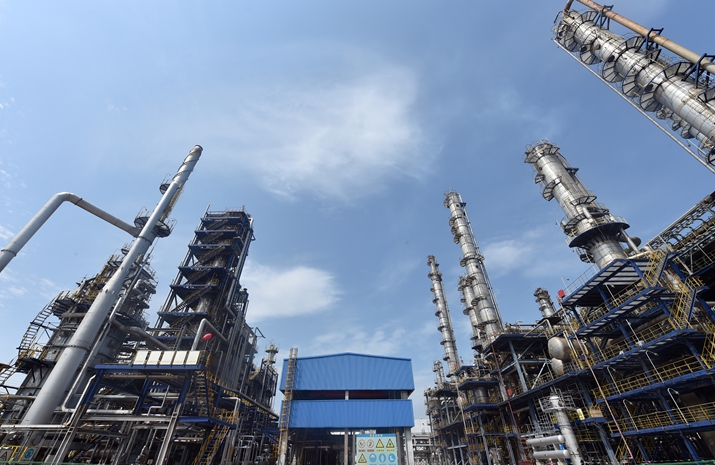| China |
| Chinese enterprises seek low-carbon production and operation to meet carbon neutral goals | |
|
|
 A China-built hydropower station in Koh Kong Province, Cambodia, on November 24, 2020 (XINHUA)
In July, China Petrochemical Corp. (Sinopec Group), one of the world's largest petrochemical companies, initiated China's first million-ton carbon capture, utilization and storage (CCUS) project in an oilfield in Shandong Province. The project, which will be put into production by the end of this year, is estimated to reduce carbon dioxide emissions by 1 million tons per year, the equivalent of planting nearly 9 million trees. CCUS is an important technical means to cope with global climate change and control greenhouse gas emissions, capturing and purifying carbon dioxide emitted during production and utilizing it in a new production process for recycling and storage. According to the International Energy Agency, it will contribute about 14 percent of carbon dioxide emissions reduction by 2050. "While working to ensure China's energy supply, Sinopec is also working to reduce the carbon emissions it has caused. We aim to capture, store and utilize over 10 million metric tons of carbon dioxide by 2030 through the CCUS project," Sinopec spokesperson Yu Guoming said at the Erhai Forum on Global Ecological Civilization Construction in Dali, Yunnan Province, in October. Sinopec said it would build another million-ton CCUS demonstration base in the next five years, realizing industrialized development of the technology. The company is also exploring new methods of energy production and plans to establish 1,000 hydrogen and 7,000 photovoltaic (PV) power stations by 2025. In recent years, an increasing number of Chinese enterprises are joining the campaign to reduce carbon emissions, and it's not only the major emitters like Sinopec that are seeing the need for change. Since 2011, the Chinese Government has established seven pilot carbon trading markets to explore market-oriented mechanisms to control the greenhouse gas emissions of domestic companies. As part of its pledge to peak carbon emissions before 2030 and achieve carbon neutrality before 2060, China has built on these pilot markets by launching a national carbon market in July, with the participation of more than 2,000 power generation companies. The scheme has incentivized the participants to find greener and more energy-efficient methods of production.  A production facility of China Petrochemical Corp. in Tianjin on August 10, 2020 (XINHUA)
Low carbon, high expectations The drive for increased energy efficiency and reduced carbon emission is also bringing positive results outside the big energy-consuming industries such as power, steel and cement production. Although the electronics industry is responsible for a relatively small part of China's carbon dioxide emissions, companies have been reducing the amount of carbon they emit each year. Gong Xun, an engineer at Lenovo, the world's largest personal computer maker, told the forum the company has adopted green technologies in some of its assembly lines and introduced recyclable packaging. Tencent, another tech giant, is developing a data center to improve access to patent technologies for carbon neutrality in order to facilitate cooperation between domestic enterprises. Innovative financial solutions have also been unveiled. Elion International Investment Ltd., a subsidiary of Elion Resources Group, an energy company based in Inner Mongolia Autonomous Region, has developed a platform based on blockchain technology. The company's Executive President Lu Qi told the forum that it can record enterprises' carbon credits and help manage carbon assets in order to drive carbon trading. The drive to reduce carbon emissions is in turn driving the growth of China's new-energy sector. According to Qian Jing, Vice President of JinkoSolar, a Chinese PV module manufacturer and energy storage system integrator, the year 2020 saw the company's highest global sales since 2016, and its total installed capacity reached 70 gw. Previously, producing energy through PV technology involved high costs. However, the price of electricity produced by the company's PV project in South America was only $0.01 per kWh. "This suggests that PV power supply is becoming increasingly cheaper, which makes the future of the industry look even more promising," Qian said. China's rapidly developing PV industry is also attracting foreign enterprises. FuturaSun, an Italian manufacturer of PV modules, has built a production facility in Taizhou, Jiangsu Province. Anticipating strong growth in the global clean energy sector, the company has unveiled its plan to double the annual production capacity of its Taizhou factory to 2 gw. In September, during the general debate of the 76th Session of the UN General Assembly, President Xi Jinping announced that China would increase its support of other developing countries in expanding green and low-carbon energy production, and will construct no new coal-fired power stations abroad. According to Zhu Danwei, President of a subsidiary of power supplier China Southern Power Grid (CSG) in Yunnan Province, as of August this year, the company's total trade in electricity with Southeast Asian countries, including Viet Nam and Laos, exceeded 63 billion kw, with more than two thirds of the power exported to ease those countries' power shortages. Over 90 percent of this power was generated by clean energy sources. The trade not only enhances regional power connectivity, but also boosts international cooperation on green energy projects, Zhu said. A long drive ahead Although there appears to be strong momentum in the growth of green industries, the new-energy and low-carbon drive still has a long way to go for Chinese companies. For power suppliers, some clean energy sources are not yet stable enough to be promoted. According to Zhu, the CSG plans to increase the installed capacity of clean energy in Guangdong, Yunnan, Guizhou and Hainan provinces and Guangxi Zhuang Autonomous Region by more than 100 million kw. Since wind and solar power production is not as stable as hydropower, this goal has posed challenges for stable and sustainable clean energy supply. "Although PV technology is improving, PV projects still occupy a large amount of space. To address this, more efforts are needed to build mobile PV power stations to save space and make the best use of space available within built environments," Qian said. The responsibility not only lies with energy producers. According to Chen Ying, a researcher with the Research Institute for Eco-civilization at the Chinese Academy of Social Sciences, Chinese enterprises in a number of sectors play a key role in realizing the carbon emission and neutrality goals, and purchasing carbon quotas on the trading market is far from enough. "The key is still reducing carbon dioxide emissions and seeking industrial restructuring. Tech enterprises should also be providing technological and digital solutions for key emitters," Chen said. (Print Edition Title: In Full Swing) Copyedited by G.P. Wilson Comments to lixiaoyang@bjreview.com |
|
||||||||||||||||||||||||||||||
|
